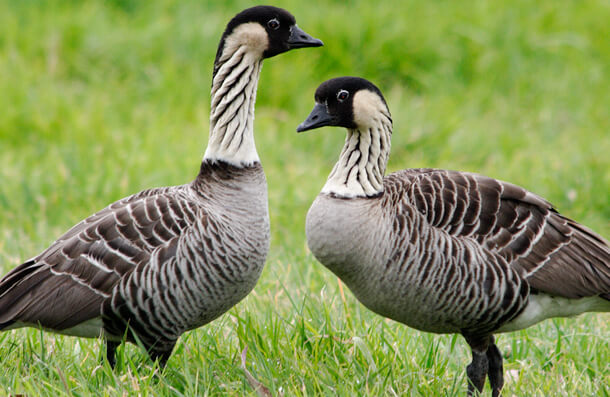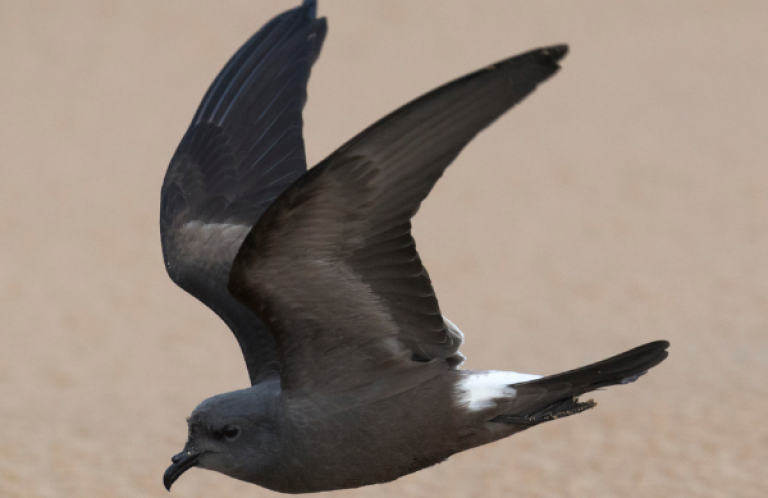Endangered Hawaiian Geese at Risk From Disease Spread by Feral Cats, Study Finds

Endangered Nene (Hawaiian Goose) is the direct and indirect victim of disease-spreading feral cats. Photo: Jack Jeffrey
Contact: Grant Sizemore, gsizemore@abcbirds.org, 202-888-7480
(Washington, D.C., June 2, 2016) A new study published in the Journal of Wildlife Diseases has documented evidence of “widespread contamination of habitat” in Hawai'i caused by feral cats. This latest research has alarming implications for endangered Hawaiian Geese (Nene) and other animals found throughout the Hawaiian Islands.
The peer-reviewed study, conducted by scientists from the United States Geological Survey, the U.S. Department of Agriculture, the University of Tennessee, and the state's Division of Forestry and Wildlife, evaluated the prevalence of infection with Toxoplasma gondii among Nene, Hawai'i's state bird. T. gondii is a protozoan parasite that causes toxoplasmosis in humans and wildlife and is the “most-commonly encountered infectious disease” in Nene, the study reports. T. gondii relies on cats to complete its life cycle and is excreted into the environment through cat feces. A single cat may excrete hundreds of millions of infectious eggs (called “oocysts”) in its feces.
The study found between 21 and 48 percent of Nene tested positive for past infection, depending on the island. The island of Moloka‘i had the highest infection rate (48 percent), followed by 23 percent on Maui and 21 percent on Kaua‘i. According to the authors, the higher rate on Moloka‘i may have been due to “a conspicuously consistent presence of feral cats.”
“This research confirms earlier studies dating from the 1970s that this parasite is probably found in tropical island ecosystems wherever there are feral cats,” said Dr. Thierry Work, the study's lead author. “Recent studies also suggest that animals and humans are more prone to trauma when infected with T. gondii. Trauma is the chief cause of death for Nene, and infections with T. gondii may be making them more vulnerable, but confirming that will require additional studies.”
Hawaiian Geese are not the only Hawaiian wildlife to test positive for T. gondii. Other birds, such as the endangered Hawaiian Crow (‘Alala), and mammals, such as endangered Hawaiian monk seals, are also susceptible and have died from infection. The National Oceanic and Atmospheric Administration (NOAA), in response to increasing seal deaths, elevated toxoplasmosis to a disease of “serious concern.” According to the Main Hawaiian Islands Monk Seal Management Plan, NOAA is concerned both with seal deaths and “the secondary and cumulative impacts of subclinical or chronic disease.”
Visitors to and residents of Hawai'i are also at risk from toxoplasmosis. Ingestion or inhalation of cat-transmitted oocysts may result in miscarriages, fetal abnormalities, blindness, memory loss, or death. A 2011 study found that nearly 80 percent of sampled mothers of congenitally infected infants (those infected by T. gondii in the womb) contracted their infections as a result of environmental contamination from cat feces.
A 2013 study by scientists from the Stanley Medical Research Institute and Johns Hopkins University also called attention to cats as the means of transmission to people. “Because cats are now so ubiquitous in the environment, one may become infected [with T. gondii] by neighboring cats which defecate in one's garden or play area, or by playing in public areas such as parks or school grounds,” the study said. “Indeed, as cats increasingly contaminate public areas with T. gondii oocysts, it will become progressively more difficult to avoid exposure.”
As well as spreading disease, cats are also a non-native predator that directly kill native wildlife in Hawai‘i and on islands around the world. In Hawai‘i, already known as the bird extinction capital of the world, feral cats kill endangered Hawaiian Petrels (‘Ua‘u), Newell's Shearwaters (‘A‘o), and Palila, among others. A 2011 study recorded feral cat impacts on at least 120 different islands worldwide and determined that feral cats are responsible for at least 14 percent of global bird, mammal, and reptile extinctions.
“While we appreciate cats as pets and acknowledge the important role pet cats play in many people's lives, it is clear that the continued presence of feral cats in our parks and neighborhoods is having detrimental impacts on people and wildlife,” said Grant Sizemore, Director of Invasive Species Programs at American Bird Conservancy. “Before another species goes extinct or another person is affected by toxoplasmosis, we need to acknowledge the severity of the problem and take decisive actions to resolve it. What is required is responsible pet ownership and the effective removal of free-roaming feral cats from the landscape.”
###
American Bird Conservancy is the Western Hemisphere's bird conservation specialist—the only organization with a single and steadfast commitment to achieving conservation results for native birds and their habitats throughout the Americas. With a focus on efficiency and working in partnership, we take on the toughest problems facing birds today, innovating and building on sound science to halt extinctions, protect habitats, eliminate threats, and build capacity for bird conservation.


















































